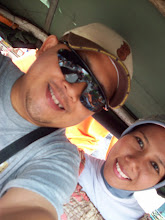 North Sulawesi was established on 23 september 1964. First Governor of North Sulawesi is Mr. Arnold Baramuli. Until 2003, North Sulawesi consist of 2 cities and 3 regencies. They are Manado and Bitung cities also Minahasa, Bolaang Mongondow and Sangihe Talaud regencies. Nowdays, North Sulawesi consist of 4 cities they are, Manado, Tomohon, Bitung, and Kotamobagu also Minahasa, Minahasa utara, Minahasa Selatan, Minahasa Tenggara, Bolaang Mongondow, Bolaang Mongondow Utara, Bolaang Mongondow Timur, Bolaang Mongondow Selatan, Sangihe, Talaud and Sitaro. North Sulawesi is one of the 32 provinces in the Republic of Indonesia, with its capital city being Manado. This region with an area of 1,533,698 ha is located at 0º30"- 4º 3" North Latitude and 121º127" East Longitude. Based on the regional government system, North Sulawesi is subdivided into the Manado Municipality, Bolaang Mongondow District, Sangihe Talaud District and Bitung Municipality. To the North this region borders on the Republic of the Philippines, Sulawesi Sea and the Pacific Ocean. The Eastern part is on the Maluku Sea and the Southern side is the Tomini Gulf. The western part borders Gorontalo Province which until the end of 2000 was a part of North Sulawesi and then became an own province.
North Sulawesi was established on 23 september 1964. First Governor of North Sulawesi is Mr. Arnold Baramuli. Until 2003, North Sulawesi consist of 2 cities and 3 regencies. They are Manado and Bitung cities also Minahasa, Bolaang Mongondow and Sangihe Talaud regencies. Nowdays, North Sulawesi consist of 4 cities they are, Manado, Tomohon, Bitung, and Kotamobagu also Minahasa, Minahasa utara, Minahasa Selatan, Minahasa Tenggara, Bolaang Mongondow, Bolaang Mongondow Utara, Bolaang Mongondow Timur, Bolaang Mongondow Selatan, Sangihe, Talaud and Sitaro. North Sulawesi is one of the 32 provinces in the Republic of Indonesia, with its capital city being Manado. This region with an area of 1,533,698 ha is located at 0º30"- 4º 3" North Latitude and 121º127" East Longitude. Based on the regional government system, North Sulawesi is subdivided into the Manado Municipality, Bolaang Mongondow District, Sangihe Talaud District and Bitung Municipality. To the North this region borders on the Republic of the Philippines, Sulawesi Sea and the Pacific Ocean. The Eastern part is on the Maluku Sea and the Southern side is the Tomini Gulf. The western part borders Gorontalo Province which until the end of 2000 was a part of North Sulawesi and then became an own province.The terrain is extremely mountainous and hilly, stretching from Lembean - Wulur Mahatus mountain chain (in Minahasa) continuing to Mount Ambang- Mount Gambuta (in Bolaang Mongondow). In Sangihe Talaud there are both active and extinct volcanoes, some towering 1,800 - 2,000 meters. Rich volcanic ash has blessed North Sulawesi with fertile lands; the highlands and lowlands producing rice, coconut, clove, nutmeg, vanilla and vegetables. The plains produce rice and corn in Dumoga, Ayong and Sangkub (Bolaang Mongondow). Plateaus in Tondano (Minahasa) also produce rice and corn, while Modoinding is know for its vegetables. Sangihe Talaud is recognized for its high quality nutmeg and Rumbia Trees (Sago Palm the source of a special flour for traditional cookies/snack). North Sulawesi is also endowed with many lakes like Lake Tondano and Lake Moat. The rivers like Ongkag Mongondow, Ongkag Dumoga, Sungai Sangkub, Randangan, Bulia and others are utilized mostly for irrigation of the ricefields. The Tondano River is used to generate electrical power for Manado and Minahasa regions.
Like other regions in Indonesia, North Sulawesi has a typical equatorial climate with two seasons: rainy and dry. Starting in September, cool Northwesterly winds pick up moisture while crossing the South China Sea and arrive in the Sulawesi Sea, about November. The wet season lasts from about November to March, and the dry season April to October. The total number of rain days is 90-130 days with approximately 3.000 mm average annual rainfall. The average temperature is 26 Celsius with the average humidity being 80%. The great 19th century naturalist, Alfred Russel Wallace (1823-1913) was the first to observe that the Indonesia archipelago is inhabited by two distinct sets of wildlife. Wallace's Line, as this boundary is still known, is drawn between Bali and Lombok and between Kalimantan and Sulawesi, and continues South of the Philippines and North of Hawaii to mark the difference in the fauna and flora which belonged to the separate land masses in the last ice age. Indigenous to Sulawesi are the Anoa (dwarf buffalo), Babi Rusa (a wilds boar with tusks growing through the roof of its mouth), black tailless macaques, kuskus, maleo bird (which incubates its 250 gram eggs in mounds of soil warmed by sunlight, hot springs or volcanic vents), tarsier (tarsius spectrum -world's smallest primate) with its head and body length of just 10 cm, brightly colored Red - knobbed Hornbill, etc. Many of these species may seen in Tangkoko Batuangus Nature Reserve and Bogani Nani Wartabone (formerly known as Dumoga Bone) National Park.
Article Source: www.woc2009.org/sulut_history.php

No comments:
Post a Comment